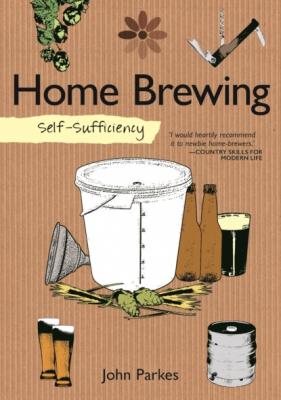ТОП просматриваемых книг сайта:
Self-Sufficiency: Home Brewing. John Parkes
Читать онлайн.Название Self-Sufficiency: Home Brewing
Год выпуска 0
isbn 9781607659716
Автор произведения John Parkes
Жанр Кулинария
Серия Self-Sufficiency
Издательство Ingram
The majority of lager in worldwide production is light in colour and usually represents the helles, pale lager or Pilsner styles. The flavour of these lighter lagers is usually mild and the producers often recommend that the beers be served refrigerated. However, the examples of lager beers produced worldwide vary greatly in flavour, colour and composition.
Most lagers are brewed in the continental style, originating in continental Europe, and consequently follow central european recipe formulations: the grist is composed mostly of Pilsner malt, Vienna malt or Munich malt, with caramel malts added to improve sweetness and head retention, and others added only for colour. The selection of hops is usually made from noble hops such as Saaz, Hallertau, Tettnanger, Strisselspalt or Lubelski.
Lagers often also feature large proportions of adjuncts, usually rice or corn. Adjuncts entered American brewing as a means of thinning out the body of American beers, balancing the large quantities of protein introduced by six-row barley. However, adjuncts are now often used in beer making to introduce a large quantity of sugar, and thereby increase ABV, at a lower price than a formulation using an all-malt grain bill.
In colour, helles and pale lager represent the lightest lagers; the darkest are Baltic porters. Darker German lagers are often referred to as dunkel lagers (dunkel meaning dark in German).
Commercial lager production
Modern methods of producing lager were pioneered in the early 19th century by brewers Gabriel Sedlmayr the Younger, who perfected dark brown lagers at the Spaten Brewery in Bavaria, and Austrian Anton Dreher, who began brewing a lager, probably of amber-red colour, in Vienna in 1840–41.
With improved modern yeast strains, most lager breweries use only short periods of cold storage, typically one to three weeks. Longer periods of storage would add hugely to the cost of lager production, although some commercial lagers are still marketed with the implication that they are matured in the ‘old-fashioned’ way.
In 1953, New Zealander Morton Coutts developed a process known as continuous fermentation (see opposite), which allowed the production of lager at a much faster pace, albeit with a reduction in flavour development. This development made possible the mass production of lager beer at a rate competitive with ales. As this technology was adopted worldwide, the light lager style emerged, quickly becoming the most popular style of beer in much of the industrialized world.
Since the 1950s, lager has displaced ale as the type of beer most consumed in the United Kingdom, and also constitutes the overwhelming majority of beer produced and sold in the United States, China, Japan, France, Italy, Russia and most, if not all, countries where beer is made and consumed.
The flavour of a lager can be quite simple, with the mildest being light lagers. Lagers with the most complex flavours are typically the darkest, although few lagers feature strong hop flavouring compared to ales of similar alcohol by volume. In general, however, lagers display less fruitiness and spiciness than ales, simply because the lower fermentation temperatures associated with lager brewing cause the yeast to produce fewer of the esters and phenols associated with those flavours. Lagers represent some of the world’s most alcoholic beers. The very strongest lagers often fall into the German-originated doppelbock style, with the strongest of these, the commercially-produced Samichlaus, reaching an ABV of 14 per cent.
The continuous fermentation plant
The drawing below shows the workings of a continuous fermenter. Wort is fed from the copper into the hold up vessel where a quantity of recycled yeast is added; the fermenting beer flows through the two continuous fermenting vessels at such a rate that the fermentation is completed when the beer flows into the yeast separator, where the yeast is separated from the beer. The yeast then flows into the yeast washer and the beer into maturation vessels (MVs). After washing with distilled water, some of the yeast is added to the hold up vessel to keep the fermentation process alive whilst the excess yeast (yeast reproduces during fermentation so there is always an excess) is sold off to make products such as yeast spreads. The carbon dioxide gas (CO2) produced is collected, compressed and then stored for sale. Efficiently it is sometimes used to dispense the beer at the point of sale.
Конец ознакомительного фрагмента.
Текст предоставлен ООО «ЛитРес».
Прочитайте эту книгу целиком, купив полную легальную версию на ЛитРес.
Безопасно оплатить книгу можно банковской картой Visa, MasterCard, Maestro, со счета мобильного телефона, с платежного терминала, в салоне МТС или Связной, через PayPal, WebMoney, Яндекс.Деньги, QIWI Кошелек, бонусными картами или другим удобным Вам способом.

